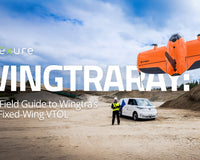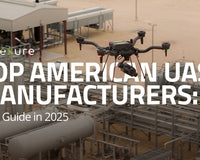When Wingtra debuted the WingtraOne in 2017, it set a new benchmark for survey-grade fixed-wing VTOL drones. WingtraOne GEN II followed in 2021 with longer legs and tighter accuracy, making high-acreage photogrammetry practical for more teams. WingtraRAY, announced for 2025, builds on that trajectory by pairing faster capture speeds with a broader sensor portfolio and workflow safeguards aimed squarely at professional survey operations.
On paper, the gains are significant: map up to 1,300 acres (≈550 ha) in a single one-hour flight, collect data about 10 times faster than multicopters and roughly 30 times faster than terrestrial methods, and achieve 1–3 cm absolute accuracy without GCPs.
WingtraRAY’s hot-swap bay accepts six dedicated payloads (including a 61MP oblique and nadir RGB, LiDAR, and multispectral), so crews can match the sensor to the mission without swapping airframes.
In this blog we’ll break down how those numbers translate to real-world workflows, explore each payload option, and outline the project profiles, like construction, mining, broad-acre agriculture, urban planning, where WingtraRAY is best suited.
Consider this your field guide to deciding whether Wingtra’s newest VTOL fits your survey toolkit.
Platform Highlights at a Glance

WingtraRAY’s airframe and software stack are designed around a simple idea: capture more usable data per hour in the field and shorten the hand-off to CAD / GIS. The details below explain how the hardware, flight logic, and workflow tools combine to meet that goal.
VTOL fixed-wing architecture
Vertical take-off and landing let crews stage from a roadside pull-off or job-site lay-down yard—no launch rails or net recovery. Once airborne, the wings take over for efficient cruise, stretching coverage to ~1,300 ac / 550 ha per flight at typical mapping altitudes.
Adaptive flight speed | 16–22 m s⁻¹ (35–49 mph)
The autopilot continuously adjusts ground speed to maintain target ground-sampling distance and overlap, even as wind or sun angle shifts. In practice this yields ≈40 % faster capture than WingtraOne GEN II without sacrificing accuracy.
Tool-free modular design
Batteries, payloads, and landing fins snap in and out; a single hard case holds the aircraft plus three extra battery sets, field charger, spares, and six hot-swap sensors. Typical turnaround between flights is under five minutes.
1.25 kg (2.75 lb) payload capacity
Enough headroom for the 61 MP inspection glass, the Wingtra LiDAR module, or the RedEdge-P multispectral stack—so you match sensor to mission without changing airframes. Full payload specs live on the WingtraRAY product page.
Connected workflow: WingtraGROUND → WingtraCLOUD
Plan on a tablet, fly hands-off, then sync images, PPK logs, and ground control to WingtraCLOUD in a single click. Deliverables export directly to common packages such as Civil 3D, TBC, or ArcGIS, reducing post-processing friction.
Built-in safeguards
Dual independent battery packs support automatic Return-to-Home on cell failure; forward and downward sensors minimise approach risk; dual-band radio with optional LTE link maintains command for extended-range or BVLOS flights.
Payload Portfolio: The Right Sensor for Every Mission

A tool-free hot-swap bay lets WingtraRAY carry six purpose-built sensors—so you can match the aircraft to each mission in minutes instead of swapping airframes.
MAP61 — Large-Area 2D & 3D Mapping

A 61 MP oblique RGB sensor captures down to 1.2 cm GSD and covers ≈550 ha (1,360 ac) at 120 m AGL with 2.7 cm GSD. PPK processing delivers ≈6 cm RMS absolute accuracy without ground control. Ideal for high-wall monitoring, open-pit volumetrics, and corridor models where fast, detail-rich 3D outputs keep projects on schedule.
SURVEY61 — Survey-Grade Photogrammetry

This 61 MP nadir RGB payload pairs a low-distortion 35 mm lens with PPK to achieve 0.5 cm GSD and ≈3 cm RMS accuracy—no GCPs required. One flight can map ≈310 ha (765 ac) at 120 m while maintaining 1.3 cm GSD, making it a fit for urban planning, construction progress, and as-built verification.
INSPECT — Millimeter-Level Inspection

Equipped with an 85 mm tele lens, INSPECTresolves 0.25 cm GSD from 60 m AGL and still covers ≈100 ha (250 ac) at 120 m with 0.5 cm GSD. PPK yields ≈3 cm RMS positional accuracy. Rail weld checks, runway FOD sweeps, and façade crack assessments benefit from this blend of reach and detail.
SURVEY24 — Accessible High-Acreage Option

A 24 MP APS-C sensor delivers 2.4 cm GSD and maps ≈330 ha (815 ac) at 120 m per sortie. With ≈6 cm RMS accuracy via PPK, SURVEY24 suits general land surveys, stockpile updates, or municipal asset inventory when budget or file-size constraints favor a lighter dataset.
MicaSense RedEdge-P — Multispectral + RGB

Five narrow bands plus a 5.1 MP panchromatic channel record ≈2 cm GSD and ≈180 ha (445 ac) at 120 m. Multispectral indices combine with RGB detail for crop-health, forestry stress, and environmental-change monitoring—supported by ≈6 cm RMS positional accuracy for reliable temporal comparisons.
LiDAR — Terrain Through Vegetation

Wingtra’s LiDAR module teams a Hesai XT32M2X scanner (640 k pts s⁻¹) with a tactical-grade IMU to log up to 200 pts m⁻² and ≈3 cm vertical accuracy. Typical coverage is ≈430 ha (1,060 ac) at 50 pts m⁻². Use it for cut-and-fill modelling, bare-earth DTMs beneath canopy, or utility-corridor clearance checks where point-cloud density and absolute accuracy matter.
Workflow: From Field to Finished Deliverables in Hours

WingtraRAY’s software stack is designed so flight crews and office teams hand files back and forth with minimal idle time. Each stage—planned on WingtraGROUND, executed automatically in the air, and finalized in WingtraCLOUD—removes manual touches that typically slow data from field to CAD.
-
Plan – In WingtraGROUND, define the polygon, altitude, and overlap; the tablet app auto-checks ground control targets and wind limits, then loads the mission to the aircraft in under five minutes.
-
Fly – Tap “Start” and the VTOL launches vertically, transitions to cruise, and follows its flight lines hands-off. A 250-acre (100-ha) site typically requires about ten minutes of airtime at mapping altitude.
-
Sync – As soon as the drone lands, imagery and PPK logs transfer to WingtraCLOUD via Wi-Fi or LTE. Field crews can swap batteries and payloads for the next sortie while office staff review incoming thumbnails and metadata in real time.
-
Process – WingtraCLOUD applies PPK correction, aligns photos, and generates orthos, point clouds, and DSMs in the project’s preset coordinate system—about two hours for the 250-acre example.
-
Export – Deliverables push directly to common CAD and GIS platforms, so engineers receive surface models and contours before the crew has even left the site. With this loop, same-day cut-and-fill calculations, volume reports, or multispectral indices become the routine rather than the exception.
Operations Over People: Optional Parachute Add-On
WingtraRAY’s optional parachute unlocks FAA Category 3 approval for Operations Over People, clearing flights across roughly 98 percent of U.S. land without the waiver paperwork that can stall urban survey schedules. The self-contained module mounts in minutes and includes a manual trigger as a final layer beyond Return-to-Home and obstacle avoidance. In practice, that means you can document a downtown utility corridor or monitor a highway deck while traffic flows beneath—confident the aircraft meets the airborne-risk thresholds regulators require.
Industry Spotlights: Where WingtraRAY Fits
Construction & Surveying
With the SURVEY61 payload, contractors can map a 250-acre earthworks site in ten minutes, generate 1–3 cm-accurate orthomosaics, and run automated cut-and-fill calculations the same afternoon. When finer detail is required—checking rebar placement or bridge-deck cracking—crews swap to INSPECT61, which resolves 0.25 cm GSD from 60 m AGL without lane closures or scaffold. The blend of area coverage and millimetre-level inspection keeps projects on schedule while trimming field hours.
Precision Agriculture
The RedEdge-P multispectral sensor delivers five narrow bands plus RGB at ~2 cm GSD, allowing a 640-acre broad-acre farm to be flown before midday. Growers use the resulting NDVI and chlorophyll maps to target variable-rate applications the same day, while weekly flights reveal crop-health trends that would be impractical with manned aircraft. The VTOL launch also means no runway or hangar logistics during peak season.
Mining & Aggregates
Wingtra’s LiDAR module pairs 200 pts m⁻² density with ~3 cm vertical accuracy, capturing a 430-ha open-pit in a single sortie—even through sparse canopy. Combined with MAP61 imagery, mine engineers produce bare-earth DTMs, high-wall profiles, and stockpile volumes accurate to within a few percent, supporting monthly reconciliation without interrupting haul-truck traffic.
Land Management
For state forests and watershed projects, MAP61 offers 1.2 cm GSD while covering more than 500 ha per flight. Agencies document canopy height, skid trails, and erosion channels, then feed the georeferenced data into GIS for harvest planning, fire-break layout, and habitat monitoring—tasks that previously required a mix of satellite imagery and on-foot transects.
Urban Planning
Dense redevelopment zones benefit from SURVEY61’s no-GCP workflow: planners collect 1.3 cm GSD imagery over 310 ha at 120 m AGL and integrate the ortho directly into parcel databases. When façade or roof condition data is needed, INSPECT61’s tele lens resolves sub-centimetre defects from a safe standoff, giving municipalities a quicker, non-invasive way to prioritise maintenance across hundreds of structures.
Frequently Asked Questions
1. What return on investment can I expect?
Firms flying 25 or more survey projects a year typically recover the WingtraRAY’s capital cost within three to six months through reduced field hours, faster deliverables, and the ability to bid larger jobs with the same crew.
2. How much ground can one flight cover?
Coverage depends on the sensor: MAP61 can map ≈550 ha (1,360 ac) at 2.7 cm GSD in about an hour, SURVEY61 covers ≈310 ha (765 ac) at 1.3 cm GSD, and the LiDAR module logs ≈430 ha (1,060 ac) at 50 pts m⁻². Smaller sites benefit from even higher-resolution passes.
3. Do I need ground control points?
Not always. SURVEY61 and MAP61 both achieve 1–3 cm absolute accuracy via PPK alone, so GCPs become optional for most topographic and as-built tasks. Adding a few well-placed points can still help when regulatory or QA requirements demand independent checks.
4. How long does it take to process the data?
For a typical 250-acre earthworks site, imagery and PPK logs sync to WingtraCLOUD in minutes and produce orthomosaics, DSMs, and point clouds in roughly two hours. LiDAR projects of similar size process on a similar timeline because georeferencing occurs in flight.
5. What is the flight endurance and battery life?
With a standard payload, WingtraRAY flies about 60 minutes under nominal conditions. The heavy-flyer bundle adds three extra battery sets and a field charger, enabling continuous operation throughout the workday with five-minute turnaround between sorties.
6. How quickly can I swap payloads or batteries in the field?
All modules are tool-free: slide the current sensor out, seat the new one, replace batteries if needed, and run the pre-flight checklist—typically under five minutes, which often finishes before data from the previous flight has finished uploading.
7. Do I need a recurring software subscription?
WingtraGROUND (tablet) is bundled with the aircraft. WingtraCLOUD offers both subscription and pay-per-project options; many survey teams build the per-project fee into client proposals so there’s no standing overhead during slower seasons.
8. How steep is the learning curve for new pilots?
Because flight planning and execution are automated, most licensed UAV operators reach production readiness after a single day of training that covers mission planning in WingtraGROUND, safety checks, and WingtraCLOUD processing.
9. What weather conditions can it handle?
The airframe is rated for operations in winds up to about 12 m s⁻¹ (≈27 mph) and temperatures from –20 °C to +50 °C (–4 °F to +122 °F). Obstacle sensors and the parachute add margin in gusty or thermally active conditions, but flights should still follow local aviation guidelines.
10. Which file formats can I export?
WingtraCLOUD outputs GeoTIFF orthomosaics, LAS/LAZ point clouds, DXF contours, and CSV/POS files. These import directly into common packages such as Civil 3D, Trimble Business Center, ArcGIS, and most mine-planning suites without additional conversion.
Take Your Surveys Further

WingtraRAY is built for teams that measure success in flight hours saved, acres captured, and deliverables turned around before the next crew meeting. Whether you’re expanding beyond multicopters or already flying WingtraOne GEN II and looking to upgrade, the modular airframe and six-sensor payload suite give you room to grow without adding complexity. Ready to see what faster capture, same-day processing, and waiver-free urban flights could mean for your projects? — Learn More and connect with our UAS specialists to chart the best configuration for your workflow.












